 |
| May 14, 2024 | Volume 20 Issue 18 |
Mechanical News & Products
Designfax weekly eMagazine
Archives
Partners
Manufacturing Center
Product Spotlight
Modern Applications News
Metalworking Ideas For
Today's Job Shops
Tooling and Production
Strategies for large
metalworking plants
What's a SLIC Pin®? Pin and cotter all in one!
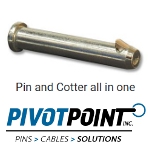 The SLIC Pin (Self-Locking Implanted Cotter Pin) from Pivot Point is a pin and cotter all in one. This one-piece locking clevis pin is cost saving, fast, and secure. It functions as a quick locking pin wherever you need a fast-lock function. It features a spring-loaded plunger that functions as an easy insertion ramp. This revolutionary fastening pin is very popular and used successfully in a wide range of applications.
The SLIC Pin (Self-Locking Implanted Cotter Pin) from Pivot Point is a pin and cotter all in one. This one-piece locking clevis pin is cost saving, fast, and secure. It functions as a quick locking pin wherever you need a fast-lock function. It features a spring-loaded plunger that functions as an easy insertion ramp. This revolutionary fastening pin is very popular and used successfully in a wide range of applications.
Learn more.
Engineering challenge: Which 3D-printed parts will fade?
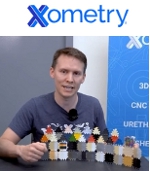 How does prolonged exposure to intense UV light impact 3D-printed plastics? Will they fade? This is what Xometry's Director of Application Engineering, Greg Paulsen, set to find out. In this video, Paulsen performs comprehensive tests on samples manufactured using various additive processes, including FDM, SLS, SLA, PolyJet, DLS, and LSPc, to determine their UV resistance. Very informative. Some results may surprise you.
How does prolonged exposure to intense UV light impact 3D-printed plastics? Will they fade? This is what Xometry's Director of Application Engineering, Greg Paulsen, set to find out. In this video, Paulsen performs comprehensive tests on samples manufactured using various additive processes, including FDM, SLS, SLA, PolyJet, DLS, and LSPc, to determine their UV resistance. Very informative. Some results may surprise you.
View the video.
Copper filament for 3D printing
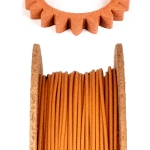 Virtual Foundry, the company that brought us 3D-printable lunar regolith simulant, says its popular Copper Filamet™ (not a typo) is "back in stock and ready for your next project." This material is compatible with any open-architecture FDM/FFF 3D printer. After sintering, final parts are 100% pure copper. Also available as pellets. The company says this is one of the easiest materials to print and sinter. New Porcelain Filamet™ available too.
Virtual Foundry, the company that brought us 3D-printable lunar regolith simulant, says its popular Copper Filamet™ (not a typo) is "back in stock and ready for your next project." This material is compatible with any open-architecture FDM/FFF 3D printer. After sintering, final parts are 100% pure copper. Also available as pellets. The company says this is one of the easiest materials to print and sinter. New Porcelain Filamet™ available too.
Learn more and get all the specs.
Copper foam -- so many advantages
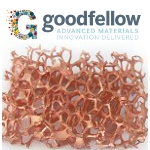 Copper foam from Goodfellow combines the outstanding thermal conductivity of copper with the structural benefits of a metal foam. These features are of particular interest to design engineers working in the fields of medical products and devices, defense systems and manned flight, power generation, and the manufacture of semiconductor devices. This product has a true skeletal structure with no voids, inclusions, or entrapments. A perennial favorite of Designfax readers.
Copper foam from Goodfellow combines the outstanding thermal conductivity of copper with the structural benefits of a metal foam. These features are of particular interest to design engineers working in the fields of medical products and devices, defense systems and manned flight, power generation, and the manufacture of semiconductor devices. This product has a true skeletal structure with no voids, inclusions, or entrapments. A perennial favorite of Designfax readers.
Learn more.
Full-color 3D-printing Design Guide from Xometry
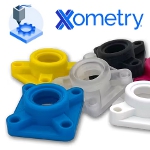 With Xometry's PolyJet 3D-printing service, you can order full-color 3D prints easily. Their no-cost design guide will help you learn about different aspects of 3D printing colorful parts, how to create and add color to your models, and best practices to keep in mind when printing in full color. Learn how to take full advantage of the 600,000 unique colors available in this flexible additive process.
With Xometry's PolyJet 3D-printing service, you can order full-color 3D prints easily. Their no-cost design guide will help you learn about different aspects of 3D printing colorful parts, how to create and add color to your models, and best practices to keep in mind when printing in full color. Learn how to take full advantage of the 600,000 unique colors available in this flexible additive process.
Get the Xometry guide.
Tech Tip: How to create high-quality STL files for 3D prints
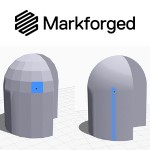 Have you ever 3D printed a part that had flat spots or faceted surfaces where smooth curves were supposed to be? You are not alone, and it's not your 3D printer's fault. According to Markforged, the culprit is likely a lack of resolution in the STL file used to create the part.
Have you ever 3D printed a part that had flat spots or faceted surfaces where smooth curves were supposed to be? You are not alone, and it's not your 3D printer's fault. According to Markforged, the culprit is likely a lack of resolution in the STL file used to create the part.
Read this detailed and informative Markforged blog.
Test your knowledge: High-temp adhesives
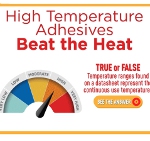 Put your knowledge to the test by trying to answer these key questions on how to choose the right high-temperature-resistant adhesive. The technical experts from Master Bond cover critical information necessary for the selection process, including questions on glass transition temperature and service temperature range. Some of the answers may surprise even the savviest of engineers.
Put your knowledge to the test by trying to answer these key questions on how to choose the right high-temperature-resistant adhesive. The technical experts from Master Bond cover critical information necessary for the selection process, including questions on glass transition temperature and service temperature range. Some of the answers may surprise even the savviest of engineers.
Take the quiz.
Engineer's Toolbox: How to pin a shaft and hub assembly properly
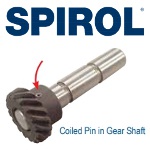 One of the primary benefits of using a coiled spring pin to affix a hub or gear to a shaft is the coiled pin's ability to prevent hole damage. Another is the coiled pin absorbs wider hole tolerances than any other press-fit pin. This translates to lower total manufacturing costs of the assembly. However, there are a few design guidelines that must be adhered to in order to achieve the maximum strength of the pinned system and prevent damage to the assembly.
One of the primary benefits of using a coiled spring pin to affix a hub or gear to a shaft is the coiled pin's ability to prevent hole damage. Another is the coiled pin absorbs wider hole tolerances than any other press-fit pin. This translates to lower total manufacturing costs of the assembly. However, there are a few design guidelines that must be adhered to in order to achieve the maximum strength of the pinned system and prevent damage to the assembly.
Read this very informative SPIROL article.
What's new in Creo Parametric 11.0?
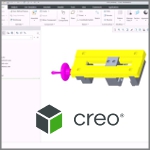 Creo Parametric 11.0 is packed with productivity-enhancing updates, and sometimes the smallest changes make the biggest impact in your daily workflows. Mark Potrzebowski, Technical Training Engineer, Rand 3D, runs through the newest functionality -- from improved surface modeling tools to smarter file management and model tree navigation. Videos provide extra instruction.
Creo Parametric 11.0 is packed with productivity-enhancing updates, and sometimes the smallest changes make the biggest impact in your daily workflows. Mark Potrzebowski, Technical Training Engineer, Rand 3D, runs through the newest functionality -- from improved surface modeling tools to smarter file management and model tree navigation. Videos provide extra instruction.
Read the full article.
What's so special about wave springs?
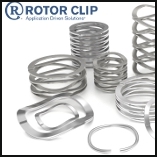 Don't settle for ordinary springs. Opt for Rotor Clip wave springs. A wave spring is a type of flat wire compression spring characterized by its unique waveform-like structure. Unlike traditional coil springs, wave springs offer an innovative solution to complex engineering challenges, producing forces from bending, not torsion. Their standout feature lies in their ability to compress and expand efficiently while occupying up to 50% less axial space than traditional compression springs. Experience the difference Rotor Clip wave springs can make in your applications today!
Don't settle for ordinary springs. Opt for Rotor Clip wave springs. A wave spring is a type of flat wire compression spring characterized by its unique waveform-like structure. Unlike traditional coil springs, wave springs offer an innovative solution to complex engineering challenges, producing forces from bending, not torsion. Their standout feature lies in their ability to compress and expand efficiently while occupying up to 50% less axial space than traditional compression springs. Experience the difference Rotor Clip wave springs can make in your applications today!
View the video.
New Standard Parts Handbook from JW Winco
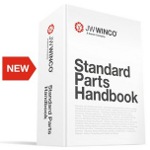 JW Winco's printed Standard Parts Handbook is a comprehensive 2,184-page reference that supports designers and engineers with the largest selection of standard parts categorized into three main groups: operating, clamping, and machine parts. More than 75,000 standard parts can be found in this valuable resource, including toggle clamps, shaft collars, concealed multiple-joint hinges, and hygienically designed components.
JW Winco's printed Standard Parts Handbook is a comprehensive 2,184-page reference that supports designers and engineers with the largest selection of standard parts categorized into three main groups: operating, clamping, and machine parts. More than 75,000 standard parts can be found in this valuable resource, including toggle clamps, shaft collars, concealed multiple-joint hinges, and hygienically designed components.
Get your Standard Parts Handbook today.
Looking to save space in your designs?
 Watch Smalley's quick explainer video to see how engineer Frank improved his product designs by switching from traditional coil springs to compact, efficient wave springs. Tasked with making his products smaller while keeping costs down, Frank found wave springs were the perfect solution.
Watch Smalley's quick explainer video to see how engineer Frank improved his product designs by switching from traditional coil springs to compact, efficient wave springs. Tasked with making his products smaller while keeping costs down, Frank found wave springs were the perfect solution.
View the video.
Top die casting design tips
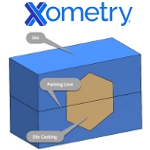 You can improve the design and cost of your die cast parts with these top tips from Xometry's Joel Schadegg. Topics include: Fillets and Radii, Wall Thicknesses, Ribs and Metal Savers, Holes and Windows, Parting Lines, and more. Follow these recommendations so you have the highest chance of success with your project.
You can improve the design and cost of your die cast parts with these top tips from Xometry's Joel Schadegg. Topics include: Fillets and Radii, Wall Thicknesses, Ribs and Metal Savers, Holes and Windows, Parting Lines, and more. Follow these recommendations so you have the highest chance of success with your project.
Read the full Xometry article.
What's the latest from 3D Systems? Innovations for different industries, processes
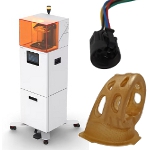 3D Systems unveiled several new solutions at the RAPID+TCT 2025 show in April designed to change the way industries innovate. From new 3D printers and materials for high-mix, low-volume applications to marked improvements in how investment casting can be done, learn what is the state of the art from the original inventors of 3D printing.
3D Systems unveiled several new solutions at the RAPID+TCT 2025 show in April designed to change the way industries innovate. From new 3D printers and materials for high-mix, low-volume applications to marked improvements in how investment casting can be done, learn what is the state of the art from the original inventors of 3D printing.
Read the full article.
Clever! Indexing plungers with chamfered pins
 JW Winco has developed a new type of indexing plunger -- GN 824 -- that can independently latch into edges and grooves. This is made possible by a chamfered plunger pin. When the chamfered pin encounters a raised latching geometry, it retracts and then springs back out again once it reaches the latching point. This new indexing plunger can be ordered with axial thread for fastening and a black plastic knob for operating the indexing plunger. In a clever design, the plunger pin can be adjusted by 360 degrees to ensure that it encounters the mating surface perpendicularly. This hardware is well suited for transport frames, mechanisms, or covers that need to be locked in place quickly and securely, especially without the need for manual intervention.
JW Winco has developed a new type of indexing plunger -- GN 824 -- that can independently latch into edges and grooves. This is made possible by a chamfered plunger pin. When the chamfered pin encounters a raised latching geometry, it retracts and then springs back out again once it reaches the latching point. This new indexing plunger can be ordered with axial thread for fastening and a black plastic knob for operating the indexing plunger. In a clever design, the plunger pin can be adjusted by 360 degrees to ensure that it encounters the mating surface perpendicularly. This hardware is well suited for transport frames, mechanisms, or covers that need to be locked in place quickly and securely, especially without the need for manual intervention.
Learn more.
Like Spider-Man: Scientists develop super strong yet reusable adhesive from smart materials
Scientists from Nanyang Technological University, Singapore (NTU Singapore) have developed a smart, reusable adhesive more than 10 times stronger than a gecko's feet adhesion, pointing the way for development of reusable superglue and grippers capable of holding heavy weights across rough and smooth surfaces.
The NTU research team, led by Professor K Jimmy Hsia, found a way to maximize the adhesion of the smart adhesives by using shape-memory polymers, which can stick and detach easily when needed simply by heating them.
Writing last month in the scientific journal National Science Review, the team details their breakthrough in adhesion by designing the shape-memory polymer material in the shape of hair-like fibrils.
This smart adhesive can support extremely heavy weights, opening new possibilities for robotic grippers that allow humans to scale walls effortlessly, or climbing robots that can cling onto ceilings for survey or repair applications.
VIDEO:Scientists from NTU Singapore have developed a smart, reusable adhesive more than 10 times stronger than a gecko's feet adhesion. [Credit: NTU Singapore]
"This research is based on a fundamental understanding of the mechanisms of adhesion forces on rough surfaces. It can help us develop very strong, yet easily detachable, adhesives adaptable to rough surfaces," said Professor Hsia, President's Chair in Mechanical Engineering, NTU School of Mechanical & Aerospace Engineering (MAE) and School of Chemistry, Chemical Engineering and Biotechnology. "The technology will be very useful in adhesive grippers and climbing robots and might one day let humans climb walls like a real-life Spider-Man."
It's rubber, it's glue; it remembers its shape and clings on to you
Shape-memory polymers are materials that can hold "memories" of their previous form and return to their original shape after they have been deformed by applying external stimuli such as heat, light, or electrical current. These properties make them ideal to be used as switchable adhesives that can adapt to various surfaces.
In their testing, the researchers used a shape-memory polymer named E44 epoxy, a stiff and glass-like plastic at room temperature. Upon heating, the material turns into a soft rubber-like state that can conform and lock onto microscopic nooks and crevices. As it cools, it becomes glassy, creating extra-strong adhesive bonds due to a shape-locking effect.
When the material is reheated, it reverts to its rubbery state so it can be pulled away and easily detached from the surface it was clinging to.
The researchers found the most effective adhesion came from designing the shape-memory polymer into an array of hair-like fibrils. Each fibril had to be carefully designed -- larger fibrils had weaker adhesion, while the smaller fibrils were hard to fabricate and prone to collapse and degradation. The sweet spot was between 0.5 mm and 3 mm in radius, pushing the limits of adhesion while retaining structural integrity.
In their experiments, the researchers found that one fibril with a 19.6 mm2 cross-section could support loads up to 1.56 kg. Every additional fibril allows for more weight to be supported. A palm-sized array of 37 fibrils weighing about 30 g can hold a weight of 60 kg -- an adult human's weight.
The research paper's first author, NTU Research Fellow Dr. Linghu Changhong, said, "Our smart adhesive exemplifies how shape-memory polymers can maintain and even enhance adhesion as surface roughness increases. This overcomes the 'adhesion paradox,' which scientists have been puzzling over, where there is a decrease in adhesion strength on rough surfaces despite having more surface area for molecules to adhere to. Our tests showed that adhesion strength of the polymer increases along with surface roughness when in a solid state and decreases when in the rubbery state."
Co-corresponding author Professor Gao Huajian, formerly a Distinguished University Professor from NTU's School of MAE and currently the Xinghua University Professor at Tsinghua University, said: "For practical gripping purposes, the adhesive needs to be strong enough to stick onto a surface, yet also easily detach when needed. Switching between the two modes is vital for practical applications. Stronger adhesives can support heavier loading but tend to be harder to detach -- this is what we call a 'switchability conflict.' Our research into shape-memory polymers has resulted in an adhesive that can easily harden to stick onto surfaces, and just as easily soften to detach, all the while being able to bear heavy weights including that of a human being."
Temperature is the main control mechanism
Detaching the shape-memory polymer while it is attached to a surface in a glass state takes less than a minute of heating using a hair dryer to bring temperatures up to 60°C.Conversely, for attachment, it takes about three minutes for the material to cool down thoroughly and lock into place.
The temperature at which the polymer changes states can be controlled by adjusting the ratios of the components used to form the polymer. This allows the polymer to be used in extreme environments, such as hot weather conditions. In their testing, the researchers set the temperature at which the polymer detaches to 60°C, a temperature that falls outside most comfortable real-world conditions. This ability of the material to attach and detach using only heat lets it act as a reusable superglue that does not leave behind sticky residue on walls. It can also be used as soft grippers capable of sticking onto objects with diverse surface textures and reliably holding them for extended periods.
"At this current stage, the heating and cooling times, as well as switching temperature, restrict the number of real-world use cases," said Changhong. "However, our findings show that reducing the wait times to mere seconds is possible, and the switching temperatures can be lowered to near body temperature, dramatically opening up application possibilities."
Source: Nanyang Technological University, Singapore
Published May 2024
Rate this article
View our terms of use and privacy policy

